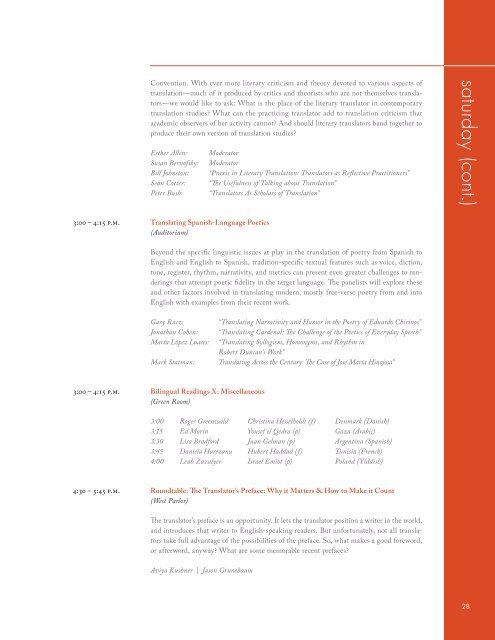2012 Conference Program - The University of Texas at Dallas
2012 Conference Program - The University of Texas at Dallas
2012 Conference Program - The University of Texas at Dallas
Create successful ePaper yourself
Turn your PDF publications into a flip-book with our unique Google optimized e-Paper software.
Convention. With ever more literary criticism and theory devoted to various aspects <strong>of</strong>transl<strong>at</strong>ion—much <strong>of</strong> it produced by critics and theorists who are not themselves transl<strong>at</strong>ors—wewould like to ask: Wh<strong>at</strong> is the place <strong>of</strong> the literary transl<strong>at</strong>or in contemporarytransl<strong>at</strong>ion studies? Wh<strong>at</strong> can the practicing transl<strong>at</strong>or add to transl<strong>at</strong>ion criticism th<strong>at</strong>academic observers <strong>of</strong> her activity cannot? And should literary transl<strong>at</strong>ors band together toproduce their own version <strong>of</strong> transl<strong>at</strong>ion studies?Esther Allen:Susan Bern<strong>of</strong>sky:Bill Johnston:Sean Cotter:Peter Bush:Moder<strong>at</strong>orModer<strong>at</strong>or“Praxis in Literary Transl<strong>at</strong>ion: Transl<strong>at</strong>ors as Reflective Practitioners”“<strong>The</strong> Usefulness <strong>of</strong> Talking about Transl<strong>at</strong>ion”“Transl<strong>at</strong>ors As Scholars <strong>of</strong> Transl<strong>at</strong>ion”s<strong>at</strong>urday (cont.)3:00 – 4:15 p.m. Transl<strong>at</strong>ing Spanish-Language Poetics(Auditorium)Beyond the specific linguistic issues <strong>at</strong> play in the transl<strong>at</strong>ion <strong>of</strong> poetry from Spanish toEnglish and English to Spanish, tradition-specific textual fe<strong>at</strong>ures such as voice, diction,tone, register, rhythm, narr<strong>at</strong>ivity, and metrics can present even gre<strong>at</strong>er challenges to renderingsth<strong>at</strong> <strong>at</strong>tempt poetic fidelity in the target language. <strong>The</strong> panelists will explore theseand other factors involved in transl<strong>at</strong>ing modern, mostly free-verse poetry from and intoEnglish with examples from their recent work.Gary Racz:Jon<strong>at</strong>han Cohen:Marta López Luaces:Mark St<strong>at</strong>man:“Transl<strong>at</strong>ing Narr<strong>at</strong>ivity and Humor in the Poetry <strong>of</strong> Eduardo Chirinos”“Transl<strong>at</strong>ing Cardenal: <strong>The</strong> Challenge <strong>of</strong> the Poetics <strong>of</strong> Everyday Speech”“Transl<strong>at</strong>ing Syllogism, Homonyms, and Rhythm inRobert Duncan’s Work”Transl<strong>at</strong>ing Across the Century: <strong>The</strong> Case <strong>of</strong> José María Hinojosa”3:00 – 4:15 p.m. Bilingual Readings X: Miscellaneous(Green Room)3:00 Roger Greenwald Christina Hesselholdt (f) Denmark (Danish)3:15 Ed Morin Yousef el Qedra (p) Gaza (Arabic)3:30 Lisa Bradford Juan Gelman (p) Argentina (Spanish)3:45 Daniela Hurezanu Hubert Haddad (f) Tunisia (French)4:00 Leah Zazulyer Israel Emiot (p) Poland (Yiddish)4:30 – 5:45 p.m. Roundtable: <strong>The</strong> Transl<strong>at</strong>or’s Preface: Why it M<strong>at</strong>ters & How to Make it Count(West Parlor)<strong>The</strong> transl<strong>at</strong>or’s preface is an opportunity. It lets the transl<strong>at</strong>or position a writer in the world,and introduces th<strong>at</strong> writer to English-speaking readers. But unfortun<strong>at</strong>ely, not all transl<strong>at</strong>orstake full advantage <strong>of</strong> the possibilities <strong>of</strong> the preface. So, wh<strong>at</strong> makes a good foreword,or afterword, anyway? Wh<strong>at</strong> are some memorable recent prefaces?Aviya Kushner | Jason Grunebaum28
















